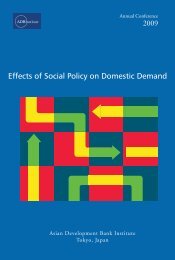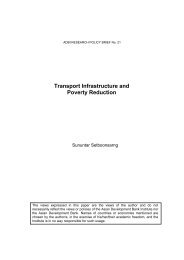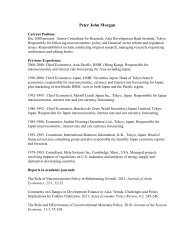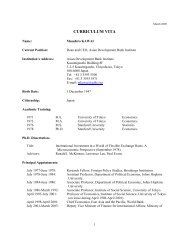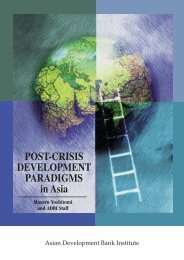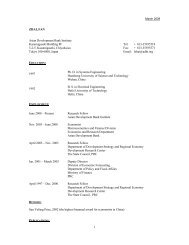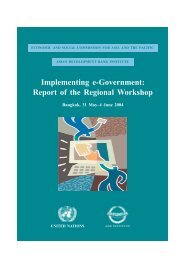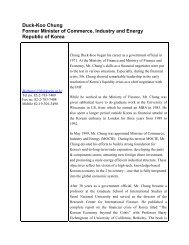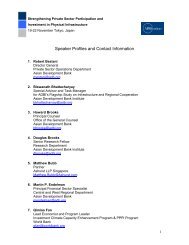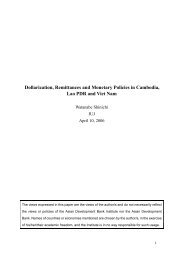(GMS) Cross Border Transport Agreement
(GMS) Cross Border Transport Agreement
(GMS) Cross Border Transport Agreement
You also want an ePaper? Increase the reach of your titles
YUMPU automatically turns print PDFs into web optimized ePapers that Google loves.
The Greater Mekong<br />
Subregion (<strong>GMS</strong>) <strong>Cross</strong><br />
<strong>Border</strong> <strong>Transport</strong> <strong>Agreement</strong><br />
Managing Regional Public Goods:<br />
<strong>Cross</strong>-<strong>Border</strong> Trade and Investment:<br />
Labor Migration and Public Health<br />
Bangkok, 15-21 June 2005<br />
Silvio Cattonar<br />
1
Scope of Presentation<br />
I. Overview of <strong>GMS</strong><br />
II.<br />
The <strong>GMS</strong> <strong>Cross</strong>-<strong>Border</strong><br />
<strong>Transport</strong> <strong>Agreement</strong><br />
III. Sample Modality of Single-<br />
Stop Inspection<br />
IV.<br />
Conclusion<br />
V. Discussion<br />
2
I. Overview of <strong>GMS</strong><br />
3
Myanmar<br />
Land area: 677 thou sq km<br />
Population: 53.2 M<br />
GDP per capita: US$320<br />
Yunnan & Guangxi, PRC<br />
Land area: 624 thou sq km<br />
Population: 92.3 M<br />
GDP per capita: US$680<br />
Thailand<br />
Land area: 513 thou sq km<br />
Population: 64.0 M<br />
GDP per capita: US$2,240<br />
Viet Nam<br />
Land area: 332 thou sq km<br />
Population: 80.9 M<br />
GDP per capita: US$480<br />
The <strong>GMS</strong> in 2003<br />
Land area: 2,554 th sq km<br />
Population: 309.4 M<br />
GDP per capita: US$875<br />
Lao PDR<br />
Land area: 237 thou sq km<br />
Population: 5.7 M<br />
GDP per capita: US$410<br />
<strong>GMS</strong> Transformation, 1992- 2003<br />
Total Exports: +193.4%<br />
Intraregional Exports: + 969.7%<br />
Annual Tourist Arrivals: + 56.8%<br />
FDI: + 140.5%<br />
Cambodia<br />
Land area: 181 thou sq km<br />
Population: 13.3 M<br />
GDP per capita: US$320<br />
4
Transformation of <strong>GMS</strong><br />
Real GDP (1992 = 100)<br />
1992<br />
2003<br />
300.0<br />
250.0<br />
Cambodia<br />
Lao PDR<br />
Total exports<br />
(US$ million)<br />
36,343 a/<br />
106,644 a/<br />
200.0<br />
150.0<br />
Myanmar<br />
Thailand<br />
Intraregional<br />
exports (US$<br />
million)<br />
1,097 a/<br />
11,735 a/<br />
100.0<br />
50.0<br />
0.0<br />
1992<br />
1993<br />
1994<br />
1995<br />
1996<br />
1997<br />
1998<br />
1999<br />
2000<br />
2001<br />
2002<br />
2003<br />
Viet Nam<br />
Yunnan<br />
Province<br />
<strong>GMS</strong><br />
Foreign direct<br />
investment<br />
(US$ million)<br />
Tourist<br />
arrivals<br />
(thousands)<br />
a/ Excludes PRC<br />
2,144<br />
9,603<br />
(1995)<br />
5<br />
5,156<br />
15,054
The THREE Cs<br />
• Connectivity<br />
• Competitiveness<br />
• Community<br />
6
11 Flagship<br />
Initiatives<br />
1 Development Matrix<br />
• From transport corridors into<br />
economic corridors.<br />
• Multistage projects with<br />
potential for private sector<br />
investment.<br />
• Trade and investment,<br />
private sector participation<br />
and competitiveness<br />
• Human Resources and Skills<br />
Competencies<br />
• Sustainable use of shared<br />
resources in the six <strong>GMS</strong><br />
countries.<br />
• Promoting the continued<br />
growth of the subregion as a<br />
single tourist destination.<br />
• Corresponding investment<br />
projects:<br />
• $10 billion to $15 billion<br />
• the <strong>GMS</strong> Development<br />
Matrix<br />
7
Connectivity<br />
<strong>GMS</strong>: Infrastructure<br />
Improvement 1992-2012<br />
8
Enhancing Competitiveness<br />
• Inter-Governmental <strong>Agreement</strong>s on travel and<br />
trade facilitation and power trade<br />
• Dramatic reduction in travel time<br />
• Removal of non-tariff barriers (<strong>Cross</strong> <strong>Border</strong><br />
<strong>Transport</strong> <strong>Agreement</strong>)<br />
• Customs facilitation<br />
• Enabling policy environment for private<br />
investments (financial sector reform, judicial<br />
reform)<br />
• Capacity Building – Phnom Penh Plan for<br />
Development Management<br />
9
Building a Community<br />
• Joint promotion of trade, investment, and tourism<br />
• New initiatives for closer cooperation such as ACMECS<br />
• Integrating Ethnic Minorities in mainstream <strong>GMS</strong><br />
development<br />
• Joint work on HIV/AIDS, Malaria, and Avian Flu<br />
• Preservation of shared environmental and cultural heritage<br />
• Economic Integration: A Common Market? From an<br />
integrated market to an economic community?<br />
10
II. The <strong>GMS</strong> <strong>Cross</strong>-<strong>Border</strong><br />
<strong>Transport</strong> <strong>Agreement</strong><br />
• History of CBTA<br />
• Issues<br />
• CBTA Geographic Coverage and Content<br />
• Status of Implementation of CBTA<br />
• Key Implementation Issues of CBTA<br />
• Sample Modality for Single-Stop Stop Inspection<br />
11
History of the CBTA<br />
• Identification of issues and review of existing international<br />
conventions (Jul-Dec 1996 under ADB SSTA)<br />
• Sixth <strong>GMS</strong> <strong>Transport</strong> Forum mandated preparation of a Framework<br />
<strong>Agreement</strong> in lieu of near-term accession to international<br />
conventions (Dec 1996)<br />
• Preparation of Framework <strong>Agreement</strong> (Jan-Sep 1998 under ADB<br />
RETA)<br />
• Negotiation of Framework <strong>Agreement</strong> (Dec 1998-Nov 1999 under<br />
ADB RETA)<br />
• Signing of the Framework <strong>Agreement</strong> by LAO, THA, and VIE (Nov<br />
1999)<br />
• Preparation of Annexes and Protocols (Nov 1999-Dec 2000 under<br />
RETA)<br />
• Accession by CAM, PRC, MYA (Nov 2001-Sep 2003)<br />
• Negotiation of Annexes and Protocols (Jan 2003- present under<br />
ADB RETAs)<br />
12
Issues<br />
• Inconsistent and difficult border crossing<br />
formalities and procedures<br />
• Restrictive visa requirements<br />
• Restrictions on entry of motor vehicles<br />
• Different standards on vehicles and<br />
drivers across countries<br />
• Transit traffic difficult/not allowed<br />
13
Overview of the <strong>GMS</strong> <strong>Cross</strong>-<strong>Border</strong> <strong>Transport</strong><br />
<strong>Agreement</strong> (CBTA)<br />
• Multilateral instrument ratified by all <strong>GMS</strong> countries<br />
• Includes references to existing international conventions<br />
• Covers key aspects of cross-border transport facilitation<br />
• Applies to selected and mutually agreed upon routes and points<br />
of entry and exit<br />
(for information on CBTA – visit http://www.adb<br />
adb.org/ .org/gms/agreement)<br />
14
Geographic<br />
Coverage of CBTA<br />
• Mukdahan – Savannakhet<br />
• Lao-Bao – Dansavanh<br />
• Aranyaprathet – Poipet<br />
• Bavet – Moc Bai<br />
• Hekou – Lao Cai<br />
• Myawaddy – Mae Sot<br />
• Mae Sai – Tachilek<br />
• Nongkhai – Thanaleng<br />
• Houayxay – Chiang Khong<br />
• Ruili – Muse<br />
• Mohan – Boten<br />
• Nam Phao – Cau Treo<br />
• Chongmek – Wang Tao<br />
• Veune Kham – Dong Kralor<br />
• Hat Lek – Cham Yeam<br />
15
Contents of CBTA<br />
1. Facilitation of <strong>Border</strong> <strong>Cross</strong>ing Formalities<br />
• Single-window inspection (SWI) and single-stop<br />
stop<br />
inspection (SSI)<br />
• Coordination of hours of operation<br />
• Advance exchange of information and clearance<br />
• Harmonization and simplification of border<br />
documents<br />
• Priority order of border crossing clearance<br />
• Application of risk management techniques<br />
• Provision of required facilities and services<br />
16
Contents of CBTA<br />
2. <strong>Cross</strong>-<strong>Border</strong> Movement of People<br />
• Issuance of visas for people engaged in cross-<br />
border transport operations<br />
• Compliance with international health quarantine<br />
conventions<br />
• Duty free allowance for private persons<br />
• Provision of cross-border passenger transport<br />
services<br />
• Implementation of carrier liability regime for<br />
cross-border passenger services<br />
17
Contents of CBTA<br />
3. <strong>Cross</strong>-<strong>Border</strong> Movement of Goods<br />
• Grant of freedom of transit through each <strong>GMS</strong><br />
country<br />
• Exemption of goods in transit from border<br />
inspections<br />
• Guarantee mechanism for cargo in transit<br />
• Compliance with international<br />
sanitary/phytosanitary<br />
agreements<br />
• Classification of dangerous goods<br />
• Classification of perishable goods and<br />
implementation of recommended standards for its<br />
carriage<br />
18
Contents of CBTA<br />
4. Requirements for the Admittance of Road Vehicles<br />
• Mutual recognition of vehicle registration<br />
certificate, registration plate, and inspection<br />
certificate<br />
• Adoption of international standards on road<br />
traffic regulations and signage<br />
• Compliance with host country third party motor<br />
vehicle liability insurance requirements<br />
• Mutual recognition of driving license<br />
• Grant of temporary admission to motor vehicles<br />
without payment of import duties and taxes<br />
19
Contents of CBTA<br />
5. Exchange of Commercial Traffic Rights<br />
• Allowing of transport operators in a <strong>GMS</strong> country<br />
to undertake cross-border transport operations<br />
• <strong>Agreement</strong> on criteria for licensing transport<br />
operators for cross-border transport operations<br />
• Setting of prices of transport services in line with<br />
market forces<br />
• Implementation of carrier liability regime for<br />
carriage of goods<br />
6. Infrastructure Requirements<br />
• Compliance of CBTA routes in line with minimum<br />
standards and specifications (ASEAN Highway<br />
Standards)<br />
20
Contents of CBTA<br />
7. Institutional Framework<br />
• Establishment of national transport facilitation<br />
committees<br />
• Establishment of Joint Committee<br />
• Coordination between border authorities of<br />
adjacent countries<br />
8. Other Provisions<br />
• Nondiscriminatory treatment<br />
• Promotion of multimodal transport and adoption<br />
of multimodal carrier liability regime<br />
• Adoption of container customs regime<br />
21
Status of Implementation of CBTA<br />
• Negotiation, Finalization, and Signing of all the<br />
remaining annexes and protocols, 2004-2005<br />
2005<br />
• Initial implementation of the <strong>Agreement</strong> at<br />
selected border crossing points, 2005-2008<br />
2008<br />
(Dansavanh-Lao<br />
Bao, Bavet-Moc<br />
Bai, Poipet-<br />
Aranyaprathet, Mukdahan-Savannakhet<br />
Savannakhet, Hekou-<br />
Lao Cai, , Mae Sot-Myawaddy<br />
Myawaddy, , Mae Sai-Tachilek<br />
Tachilek)<br />
• Ratification of all annexes and protocols, 2004-<br />
2006 (Stage 1 signed in April 2004, Stage 2 in Dec<br />
2004, and Stage 3 in 2005)<br />
• Full implementation of the <strong>GMS</strong> <strong>Cross</strong>-<strong>Border</strong><br />
<strong>Transport</strong> <strong>Agreement</strong> and its Annexes and<br />
Protocols, 2007-2008<br />
2008<br />
22
Key Implementation Issues of CBTA<br />
• Capacity building at national and border levels<br />
• Establishment of required border infrastructure<br />
• Development of ICT/MIS for efficient border<br />
management<br />
• Passage of new legislation to establish various<br />
transport facilitation regimes<br />
• Continue to strengthen goodwill and trust among <strong>GMS</strong><br />
countries<br />
23
III. Sample Modality for Single-<br />
Stop Inspection<br />
Performance in<br />
Foreign Territory - Four<br />
Steps<br />
24
Step I: Joint Customs Inspection in Common Control Area<br />
(CCA) at Country of Entry<br />
Country A<br />
Country B<br />
C-A C-B<br />
Physical Inspection<br />
CCA<br />
As required<br />
“No-Man’s Zone”<br />
Export/Transit Cargo<br />
C Q I<br />
Submission of<br />
documents<br />
I Q C<br />
Submission of<br />
documents<br />
Legend:<br />
Export/Transit Cargo<br />
C-Customs; Q-Quarantine; I-Immigration<br />
C-A C-B<br />
Physical Inspection<br />
CCA<br />
As required<br />
25
Step II: Joint Customs Inspection in Common Control Area<br />
(CCA) and Clearance/Processing of Customs Documents at<br />
Country of Entry<br />
Country A<br />
Country B<br />
C-A C-B<br />
Physical Inspection<br />
CCA<br />
As required<br />
“No-Man’s Zone”<br />
Export/Transit Cargo<br />
C-A Q I<br />
C-B<br />
Submission of<br />
documents<br />
I Q C-B<br />
Submission of<br />
documents<br />
C-A<br />
Legend:<br />
Export/Transit Cargo<br />
C-Customs; Q-Quarantine; I-Immigration<br />
As required<br />
C-A C-B<br />
Physical Inspection<br />
CCA<br />
26
Step III: Joint Customs and Quarantine Inspection in Common Control<br />
Area (CCA) and Clearance/Processing of Customs and Quarantine<br />
Documents at Country of Entry<br />
Country A<br />
Country B<br />
C-A,C-B Q-A,Q-B<br />
Physical Inspection<br />
CCA<br />
As required<br />
“No-Man’s Zone”<br />
Export/Transit Cargo<br />
C-A<br />
C-B<br />
Q-A<br />
Q-B<br />
I<br />
Submission<br />
of documents<br />
I<br />
Submission of<br />
documents<br />
Q-B<br />
Q-A<br />
C-B<br />
C-A<br />
Legend:<br />
Export/Transit Cargo<br />
C-Customs; Q-Quarantine; I-Immigration<br />
As required<br />
C-A,C-B Q-A,Q-B<br />
Physical Inspection<br />
CCA<br />
27
Step IV: Single Window and Single Stop: Joint Customs and Quarantine Inspection<br />
in Common Control Area (CCA) and Clearance/Processing of Customs, Quarantine,<br />
and Immigration Documents<br />
Country A<br />
at Country of Entry<br />
Country B<br />
C-A,C-B Q-A,Q-B<br />
Physical Inspection<br />
CCA<br />
As required<br />
“No-Man’s Zone”<br />
Export/Transit Cargo<br />
C-A<br />
C-B<br />
Q-A<br />
Q-B<br />
I-A<br />
I-B<br />
Submission<br />
of documents<br />
Submission<br />
of documents<br />
I-B<br />
I-A<br />
Q-B<br />
Q-A<br />
C-B<br />
C-A<br />
Legend:<br />
Export/Transit Cargo<br />
C-Customs; Q-Quarantine; I-Immigration<br />
As required<br />
C-A,C-B Q-A,Q-B<br />
Physical Inspection<br />
CCA<br />
28
IV. Conclusion<br />
• Connectivity: CBTA is essential in maximizing<br />
the benefits of subregional transport<br />
infrastructure<br />
• Competitiveness: CBTA will result in improved<br />
efficiency arising from easier flow of goods and<br />
people across borders:<br />
• Community: CBTA fosters greater sense of<br />
community and promotes harmonization of<br />
rules and procedures<br />
29
Thank You<br />
For more information:<br />
• <strong>GMS</strong> Program – http://www.adb<br />
adb.org/ .org/gmsgms<br />
• <strong>GMS</strong> countries - http://www.adb<br />
adb.org/Mekong<br />
• CBTA – http://www.adb<br />
adb.org/ .org/gms/agreement<br />
30
V. Discussion<br />
31
Major Achievements of the <strong>GMS</strong> Program<br />
• Mutual trust and confidence<br />
• Ownership and commitment at the highest political<br />
level<br />
• Unique institutional arrangements for cooperation<br />
• Major capacity building support (Phnom Penh Plan)<br />
• 18 loan projects (completed and ongoing) worth US$3.9<br />
billion<br />
• 95 TA projects (completed and ongoing) worth US$104<br />
million<br />
• <strong>Agreement</strong> to facilitate the cross-border transportation<br />
of goods and people<br />
• Inter-Governmental agreement on regional power trade<br />
• Promotion of the <strong>GMS</strong> as a single tourist destination<br />
• Cooperation on HIV/AIDS<br />
• Development of a strategic environment framework<br />
32



